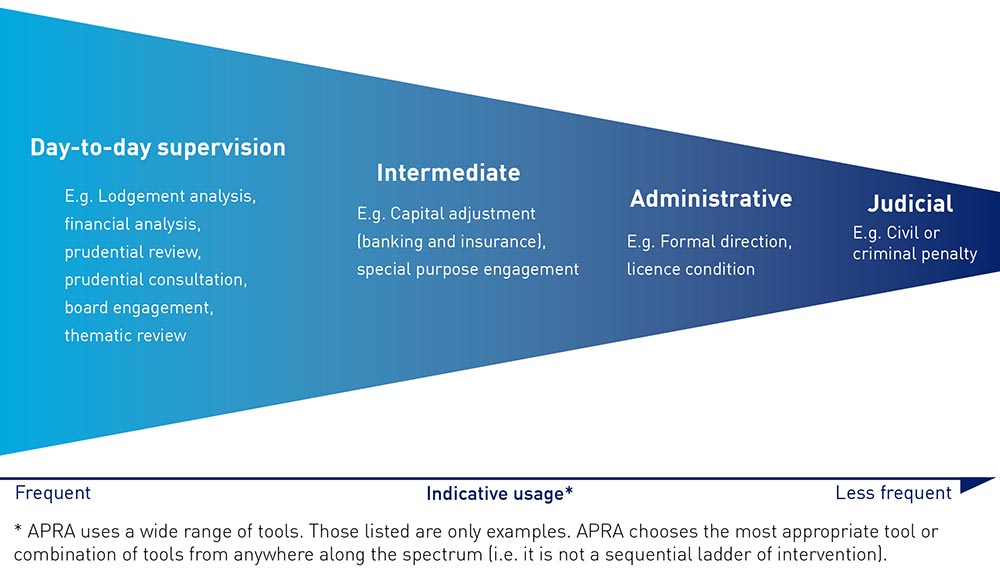APRA's new Enforcement Approach, published today, sets out how APRA will approach the use of its enforcement powers to prevent and address serious prudential risks, and to hold entities and individuals to account.
The new Enforcement Approach is founded on the results of its Enforcement Review, which has also been published today. The Review, conducted by APRA Deputy Chair John Lonsdale, made seven recommendations designed to help APRA better leverage its enforcement powers to achieve sound prudential outcomes.
The APRA Members formally commissioned the Enforcement Review last November in response to a range of developments, including the creation of the Banking Executive Accountability Regime, the Prudential Inquiry into Commonwealth Bank of Australia, evidence presented to the Royal Commission into Misconduct in the Banking, Superannuation and Financial Services Industry, and proposals to give APRA expanded enforcement powers, particularly in superannuation. Mr Lonsdale led the Review, supported by a secretariat within APRA. Mr Lonsdale also utilised an Independent Advisory Panel comprising Dr Robert Austin, ACCC Commissioner Sarah Court and Professor Dimity Kingsford Smith to provide external perspectives and advice.
While APRA's appetite for taking enforcement action is closely linked to a number of other components of its supervisory approach, the Review was focused on enforcement activity and not APRA's wider operations.
APRA Chair Wayne Byres said APRA would implement all the recommendations, including:
- adopting a "constructively tough" appetite to enforcement and setting it out in a board-endorsed enforcement strategy document;
- ensuring APRA supervisors are supported and empowered to hold institutions and individuals to account, and strengthening governance of enforcement-related decisions;
- combining APRA's enforcement, investigation and legal experts in one strengthened support team, and ensuring resources are available to support the pursuit of enforcement action where appropriate; and
- strengthening cooperation on enforcement matters with the Australian Securities and Investments Commission (ASIC).
Mr Lonsdale said the Review found APRA had, on the whole, performed well in its primary role of protecting the soundness and stability of institutions. But he said APRA could achieve better outcomes in the future by taking stronger action earlier where entities were not cooperative or open, and by being more willing to set public examples.
"APRA's strong focus on financial risk has ensured the ongoing stability of Australia's financial system, even during periods of financial and market stress, and protected the interests of bank depositors, insurance policyholders and superannuation members. But to remain effective, we must continue to evolve and improve, especially in response to the ways in which non-financial risks, such as culture, can impact on prudential outcomes.
"The recommendations of the Review will still mean that APRA as a safety regulator remains focused on preventing harm with the use of non-formal supervisory tools. However, APRA will be more willing to use the full range of its formal powers - such as direction powers and licence conditions - to achieve prudential outcomes and deter unacceptable practices," Mr Lonsdale said.
Mr Byres thanked Mr Lonsdale and the APRA Review team for delivering a valuable piece of work that would sharpen APRA's ability to hold entities and their leaders to account. He said enforcement activity is not intended to be a separate or stand-alone function, but rather a set of tools that APRA supervisors would use more actively, particularly in the case of uncooperative institutions. (See Figure 1)
"Having joined APRA only last October, John brought a fresh set of eyes to the task of examining APRA's historical approach to enforcement. The Review acknowledges that as a supervision-led prudential regulator, APRA's primary focus will always be on resolving issues before they cause problems for depositors, insurance policyholders and superannuation members, rather than relying on backward-looking actions after harm has occurred. In most cases, we will continue to achieve this through non-formal tools.
"However, formal enforcement is an important weapon in our armoury when non-formal approaches are not delivering prudential outcomes. Particularly as our powers have recently been strengthened in a number of areas, the new Enforcement Approach will ensure we make use of those powers as the Parliament intended. That means that in future, APRA will be less patient with the time taken by uncooperative entities to remediate issues, more forceful in expressing specific expectations, and prepared to set examples using public enforcement to achieve general deterrence.
"With the release of APRA's revised Enforcement Approach today, the new enforcement appetite comes into effect immediately," Mr Byres said.
Mr Byres indicated support for the recommendations on legislative change, and that these would be referred to the Government for its consideration. He also welcomed the recent passage of the Treasury Laws Amendment (Improving Accountability and Member Outcomes in Superannuation Measures No 1) Bill 2019 as a useful complement to APRA's renewed enforcement appetite.
The Panel, led by Graeme Samuel, currently undertaking a Capability Review of APRA will take into account APRA's new Enforcement Approach in its work.
The Final Report of the Review and APRA's Enforcement Approach are available on APRA's website at: https://www.apra.gov.au/enforcement.
Figure 1: Indicative usage of supervisory tools







